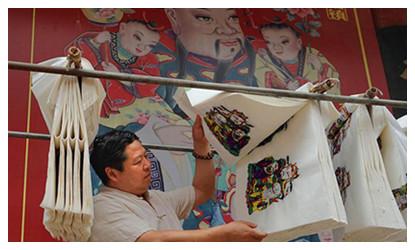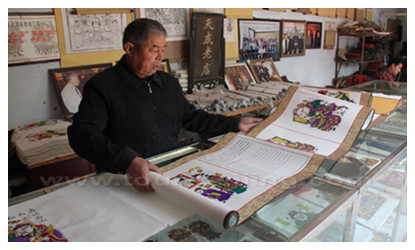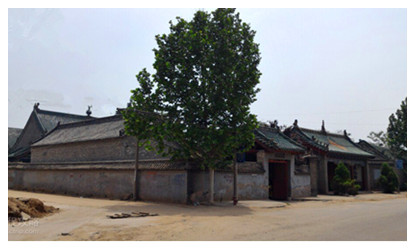Skype: neodalle-travel
Tel: +86 135 7447 2266
E-mail: sales@zhangjiajieholiday.com
Zhuxian Town lies 23km south of Kaifeng City,Central China's Henan Province.It was regarded as one of the four China's famous towns in the Qing Dynasty(1644-1911).
 Zhuxian Town is notable for its over 1000 year-old craft of woodblock new year paintings which was listed in the National Intangible Cultural Heritage in 2006.Andlots of historical and cultural constructures and sites are preserved well in Zhuxian Town so that it has attracted more and more visitors from home and abroad in recent years.
Zhuxian Town is notable for its over 1000 year-old craft of woodblock new year paintings which was listed in the National Intangible Cultural Heritage in 2006.Andlots of historical and cultural constructures and sites are preserved well in Zhuxian Town so that it has attracted more and more visitors from home and abroad in recent years.
History of Zhuxian Town
Zhuxian Town was established during the Warring States Period (475-221BC), by the name of the famous general Zhu Hai of the Wei State. In the period from the Ming Dynasty (1368-1644) to the middle of Qing Dynasty (1644-1911), Zhuxian Town was one of the four most famous towns in China. And among China’s four most famous New Year Picture producers, Zhuxian is the oldest (the other three being Yangliuqing in Tianjin, Wuqiang City in Hebei Province and Weifang in Shandong Province).
What to see in Zhuxian Town ?
Zhuxian Town Woodblock new year paintings
Traditionally, when Chinese lunar new year ( Spring Festival ) comes, families would paste new year paintings on their door frames and houses with the prints of new year pictures. New year paintings represent a good luck and fortune to say goodbye to the past year and welcome the new year. New year pictures are kinda of unique Chinese traditional folk culture.The Zhuxian Town woodblock new year paintings are one of the most famous man-made new year paintings in China.
The woodblock new year paintings in Zhuxuan Town is an untangible cultural heritage in China. It has been on the verge of extinction due to the new printing technology. The procedures of making woodblock new year paintings include draft, engraving, rubbing and apply colors. The most difficult part is to engrave blocks. Usually one engraved block takes 5 or 6 days. The Basically, one color needs one block. So one woodblock new year picture needs at least 5 or 6 blocks for 5 or 6 colors (red,yellow,green,black and blue). The Zhuxian Town new year painting is famous for its bright and bold colors. The pigment is made of plants and other natural materials and never fades.

A craftman would brush black color on a woodblock, put on a piece of rice paper and rub it for its outline, then dry it. The process is repeated for other colors required. One color and one block. The themes of the paintings feature Chinese fairy tales and tales of folklore.
Tiancheng Nianhua Old Shop ( Tiancheng Woodblock New Year Painting Old Shop)is one of the oldest woodblock shops in Zhuxian Town. The owner of the shop is Mr. Yin Guoquan, the fifth generation of the woodblock new year paintings. His family has been in woodblock new year painting business for over 200 years. His two grandsons have started to take over his job, so Yin family’s woodblock new year painting has reached its 7th generation.
Zhang Jizhong, a wood engraving maker, checks his New Year printings at a studio in Zhuxian town of Kaifeng city, Central China’s Henan province, July 16, 2016.
Judaism Mosque in Zhuxian Town
The Kaifeng Jews, one of many pockets of Chinese Jews living in ancient China, refer to this tattoo in two of their three stele monuments created in 1489, 1512, and 1663. The first mention appeared in a section of the 1489 stele referring to the Jews' "Boundless loyalty  to the country and Prince."The second appeared in a section of the 1512 stele about how Jewish soldiers and officers in the Chinese armies were "boundlessly loyal to the country."
to the country and Prince."The second appeared in a section of the 1512 stele about how Jewish soldiers and officers in the Chinese armies were "boundlessly loyal to the country."
Kaifeng Synagogue,or Kaifeng Jewdaism Mosque,is lolcated in Zhuxian Town,23km south of Kaifeng City, Henan Province. it is the only Jewish synagogue in China whose origins can be traced back to the earliest migration of Youtai ("Jews") to the country, who are believed to have arrived in China from Central Asia, possibly from India.
The synagogue was allegedly built in 1163 – Kaifeng (formerly known variously as Bianliang) was the capital city of the Song (960-1279) Dynasty. The synagogue was unfortunately destroyed in the 1860s and was never rebuilt.Thanks, however, to the French-Chinese priest, Meng Zhengqing, who once sketched two pictures of this synagogue – one depicting the entire synagogue and one depicting the synagogue's inner decoration – the true appearance of Kaifeng's old Jewish synagogue can be seen.
The site where the synagogue once stood, behind a row of busy shops in a merchant district during the period in question, is situated in Tiger Hole Street in the village of Zhuxian. Buses from Kaifeng Coach Station regularly service Zhuxian. The fare is 7 yuan per direction. The Chinese Spring Festival pictures that are produced at the site of the synagogue are decidedly worth the price.
Travel Tips
Address: Zhuxian Town, West Bank of Yunliang River, Xiangfu District, Kaifeng City, Henan Province
Opening hours 8:00-18:00
Entrance Fee: CNY 80
 Ask Questions ?
Ask Questions ?